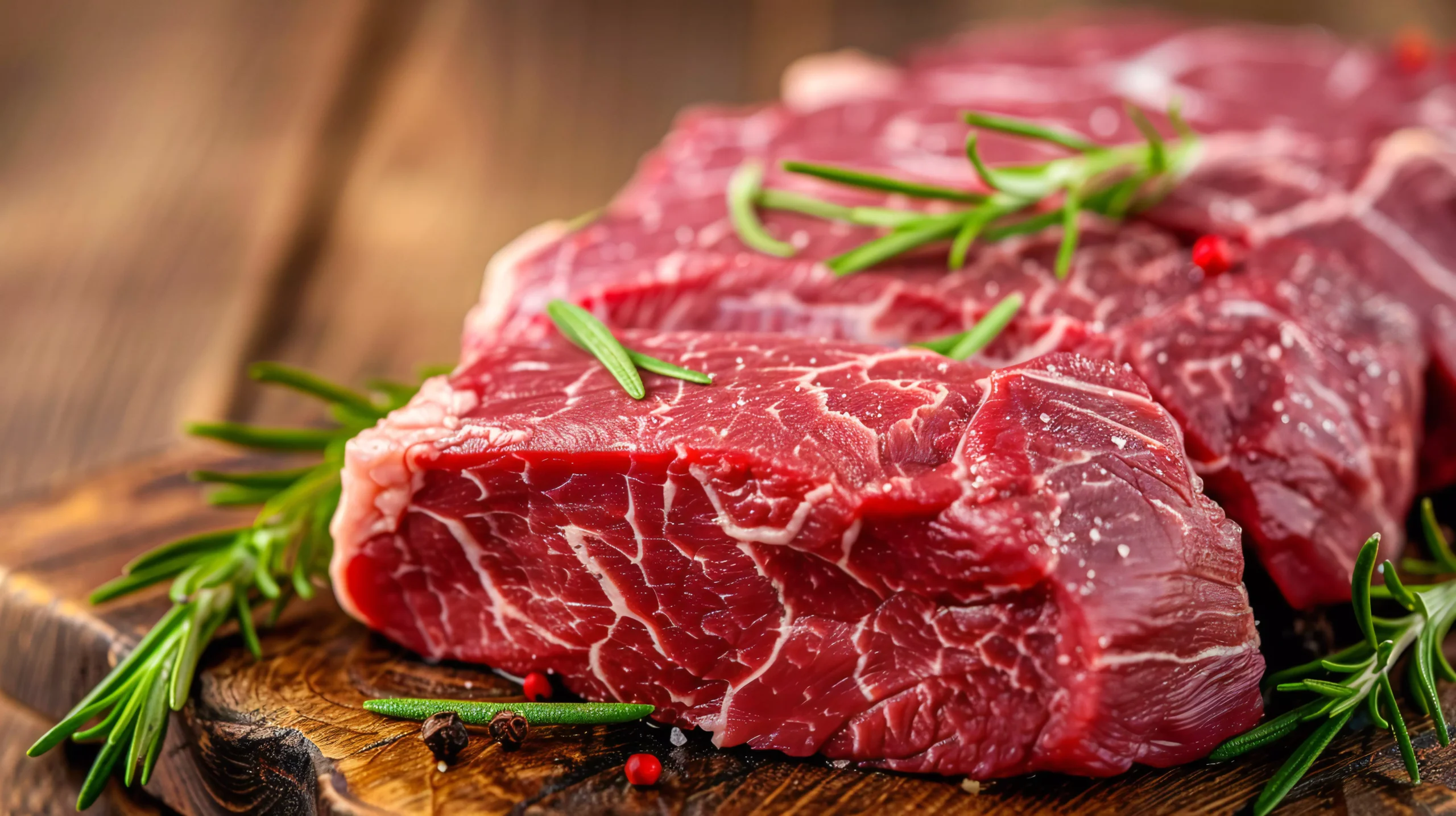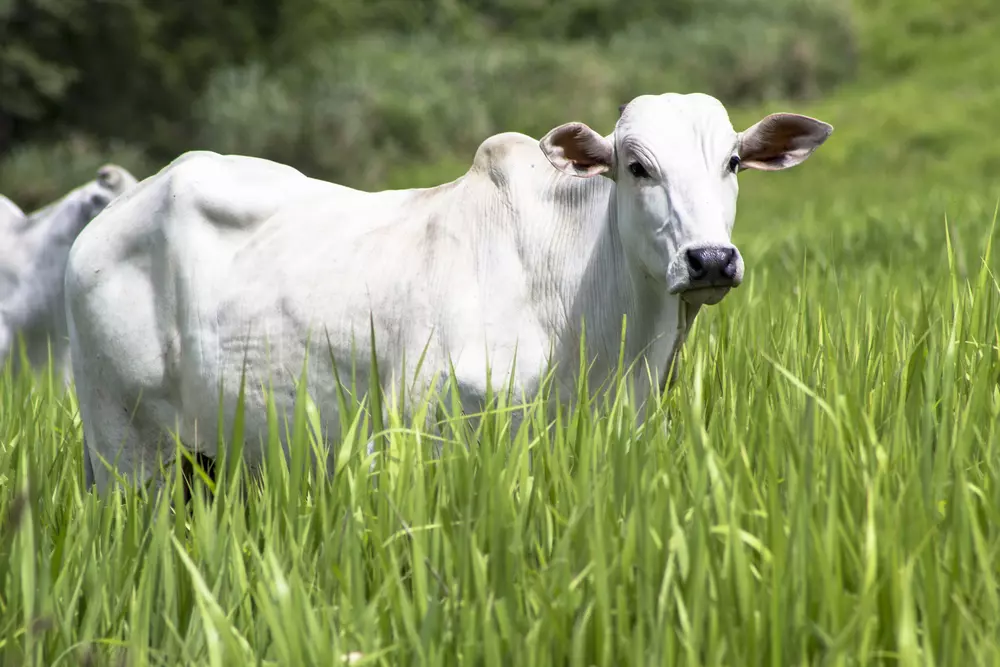Science shows that it is. It’s a matter of balance! A diverse diet consisting of grains, vegetables, fruits, eggs, meat, fish, dairy, and oils provides the necessary energy to keep the body active and healthy. According to the World Health Organization (WHO), variety in food intake is crucial for preventing nutritional deficiencies and chronic diseases.
A 2022 study published in Frontiers in Nutrition revealed that a higher dietary diversity is linked to lower mortality rates. Another study this year, found that seniors with more varied diets tend to maintain better health, preserving essential skills and capacities.
The origin of red meat

Photo: VetalStock / Adobe Stock
Although red meat is typically associated with cattle, it also comes from various other animals. This includes lamb and mutton, goat, deer, and pigs. What matters is the presence of myoglobin, a protein that gives its muscle tissue its color.
It was with the domestication of animals such as cattle, sheep, goats, pigs, and chickens, about 10,000 years ago, that meat became a more accessible and constant part of the human diet. “Red meat has been an essential part of the human diet for millennia, providing a source of high-quality protein, micronutrients, and essential fatty acids,” notes a review of studies published this year in the scientific journal Animal.
Throughout history, humans have incorporated foods into their diet rather than limiting them. Although it is difficult to precisely reconstruct ancestral human diets, it is known that they were varied and similar to those of modern hunter-gatherers – these populations, incidentally, exhibit lower rates of chronic diseases compared to people with more industrialized diets.
Red meat, pure strength
Meat is one of the main providers of high-quality protein for the human body, considered a complete source of the nutrient – meaning it contains all essential amino acids. Proteins are necessary components for the growth, construction, and repair of tissues, forming part of all cells. They also make up the composition of immune system antibodies, actively participating in various metabolic processes. Another advantage: the digestibility of meat protein is superior to that of beans and wheat. Cooked, meat contains up to 36 grams of protein per 100 grams of raw meat.
Other significant nutrients

Photo: Mediteraneo / Adobe Stock
According to the Brazilian Ministry of Health’s Dietary Guidelines for the Brazilian Population, the list of nutrients provided by meat is long:
- Iron (associated with memory and oxygenation);
- Zinc (important for immune functions and healing);
- Selenium (a powerful antioxidant);
- Omega-3 fatty acids (which aid cardiovascular health);
- Vitamin B12 (related to neurological, vascular, immunological, and inflammatory processes). With an additional factor: studies show that vitamin B12 concentrations in ruminant meats are often higher than in animals like pigs and poultry, and more iron and zinc are absorbed from red meat than from plant sources. To give an idea, 100g of beef contains about 2.6 micrograms of vitamin B12, while the same amount of spinach offers less than 0.1 microgram. This demonstrates that a human would not be able to achieve the same amount of vitamin B12 present in beef by only consuming the vegetable.
Benefits
Due to the nutritional profile of red meat, science affirms that there are indeed benefits to moderate consumption. The Ministry of Health’s recommendation is up to 500 grams per week (cooked).
A diet with adequate protein intake is associated with improved muscle strength and physical function. It is also positively correlated with life expectancy. In children, a study conducted in the US confirmed the role of beef as an important food for cognitive development.
The impact of exclusion
Removing or reducing the consumption of nutrients present in meat has consequences. A recent study shows that removing an 85-gram portion of meat or poultry from healthy dietary patterns can result in decreases (10% or more) of protein and several essential micronutrients, including iron, phosphorus, potassium, zinc, selenium, thiamine, riboflavin, niacin, vitamin B6, vitamin B12, and choline, in addition to cholesterol and sodium. According to the book “Sacred Cow” by Diana Rodgers and Robb Wolf, a lack of vitamin B12 can cause neurological disorders and anemia, while iron deficiency is also associated with anemia. Furthermore, the authors highlight that the consumption of lean meat, within a balanced diet, may be related to a lower risk of certain types of cancer.
Not ultra-processed!
When it comes to food processing, foods can be classified into three categories: ultra-processed, which involve multiple manufacturing steps and the use of various ingredients, mostly of industrial origin, such as soft drinks, filled biscuits, packaged snacks, and instant noodles; processed, which are products that have undergone the addition of salt or sugar; in natura or minimally processed foods, such as pickled vegetables, canned fruits, cheeses, and bread; and in natura, which are foods obtained directly from plants or animals and acquired for consumption without any alteration, such as leaves, fruits, eggs, and milk.
Meat falls into the minimally processed group. In a 2022 study, American researchers claim to have found weak evidence of an association between the consumption of unprocessed red meat and health complications such as colorectal cancer, breast cancer, type 2 diabetes, and ischemic heart disease.
Keeping an eye on the pasture

Photo: Alf Ribeiro/ Shutterstock
The feed given to animals can influence the total and saturated fat content and the fatty acid composition of the red meat that reaches your plate. In addition to being leaner, grass-fed cattle have more omega-3, but the positive impact goes beyond health: in terms of sustainability, this type of production is an example of regenerative livestock farming, which focuses on sustainable management practices to benefit the environment. This approach prioritizes soil conservation, animal welfare, and the integration of pastures with preservation areas and native vegetation, promoting biodiversity and reducing greenhouse gas emissions. Minerva Foods also follows other standards, such as origin traceability, ensuring environmental, labor, and land compliance, geographical monitoring of farms, mapping of production cycles (breeding, rearing, and fattening), social investment, and technical development of people.
When preparing
According to the Brazilian Ministry of Health, the most recommended cooking methods for cuts with more fat are roasting, grilling, or sautéing. Leaner cuts, on the other hand, are good stewed. And always with the least possible amount of oil and salt. The cooking method can also influence protein absorption capacity. Cooking it at a lower temperature (55°C) for a short period of 5 minutes is more advantageous than at a high temperature (90°C) for a period longer than 30 minutes (Review: On-farm and processing factors affecting bovine carcass and meat quality).
Weight loss
Created in the 1920s as a therapeutic alternative for treating epilepsy, the ketogenic diet is one of the most adopted strategies for those looking to lose weight. With carbohydrates drastically reduced, the body seeks other sources for supplying energy to cells – in this case, fat, whose consumption is increased. The process also generates molecules that influence appetite-related hormones.




